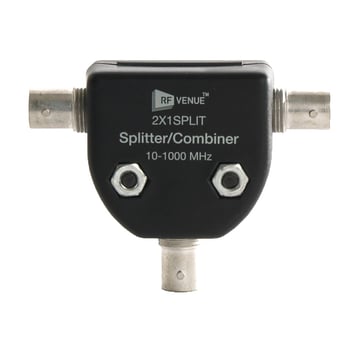- Products
- All Products
- RF PA Extension Kit
- Wireless Microphone Upgrade Packs
- In-Ear Monitor Upgrade Packs
- Wireless Microphone Antennas
- Wireless In-Ear Monitor Antennas
- Antenna Distribution for Microphones
- Antenna Combiners for In-Ear Monitors
- Multi-Zone Antenna Combiners
- Spectrum Tools
- Accessories, Cables and Parts
- Solutions by Venue
- Resources & Training
- Performance Tools
- About Us
To compare the effects of two different types of antennas (and the effectiveness of the RF Spotlight at reducing sources of interference), we traveled to New York City in search of something most professionals avoid: crowded spectrum.
We brought a camera, a wireless mic, and some other equipment and camped around 59th and 6th, just inside Central Park.
A passive coax switch fed one RF Spotlight and one CP Beam to a spectrum analyzer. The switch and analyzer let us visualize and compare what a wireless microphone receiver would "see" if either of these two antennas were attached at this location.
With the CP Beam, the signals and noise floor within the antenna's pattern are amplified (under normal circumstances, a good thing if pointed at mic transmitters). With the Spotlight, the noise floor melts away, leaving nothing but signal, loud and sweet.
The unique radiation pattern of the Spotlight creates a "bubble" (as we often say) of coverage that envelopes proximate transmitters while attenuating competing RF outside its boundaries, resulting in vastly improved signal-to-noise ratio.
Alex Milne
Alex Milne was Product Marketing Manager and Digital Marketing Manager for RF Venue, and a writer for the RF Venue Blog, from 2014-2017. He is founder and CEO of Terraband, Inc., a networking and ICT infrastructure company based in Brooklyn, NY., and blogs on spectrum management, and other topics where technology,...
More from the blog

2x1SPLIT
Three Passive Splitter Hacks for Antenna Distribution
5 min read
| May 19, 2015
Read More

COMBINE4 Transmitter Combiner
What Is Antenna Distribution?
4 min read
| December 15, 2014
Read More

COMBINE4 Transmitter Combiner
Contemporary NORTHchurch.tv Improves Wireless with Antenna Distribution
4 min read
| February 7, 2015
Read More
Subscribe to email updates
Stay up-to-date on what's happening at this blog and get additional content about the benefits of subscribing.

